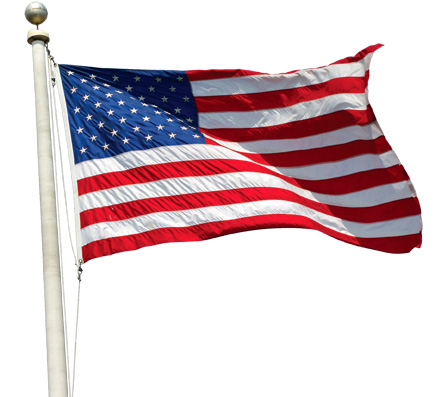Our Stars and Stripes, Forever!

It is perhaps the most patriotic symbol of our country and one that is recognized around the world. But did you know that the design of the U.S. flag has changed over time to reflect our growing country?
For more than 100 years, Great Britain’s flags also represented the American Colonies. As the colonists moved toward open rebellion in the mid-1700s, however, they wanted a flag that symbolized them and their fight for representation.
The first Colonial flags were created to identify patriot ships at sea during the Revolutionary War. The colonists modified the British flag to create the Continental Colors (or Congress Colors), which today is referred to as the Grand Union flag. The red field of the British Red Ensign flag was replaced with rebellious stripes of red and white, symbolizing the 13 Colonies, while the small version of the British Union flag in the upper left-hand corner, symbolizing the Colonies’ connection to Great Britain, remained. Other Colonial flags included a pine tree, a beaver, or a rattlesnake. Mottoes, such as “Liberty” and “Don’t Tread on Me,” often were added to these flags.
On June 14, 1777, the Second Continental Congress passed several marine laws. One stated, “Resolved, That the flag of the United States be thirteen stripes, alternate red and white: that the union be thirteen stars, white in a blue field, representing a new constellation.”
It was official. A field, or canton, of stars replaced the British Union. The new flag became known as the Stars and Stripes. Still, the design of the flag was varied, since each seamstress followed her own ideas and interpretation. Official flags might have stars with five, six, seven, or eight points. These stars were scattered or arranged in many designs. Also, the direction of the stripes (horizontal or vertical) was never specified.
In 1791 and 1792, Vermont and Kentucky joined the Union. The Senate passed a bill requiring 15 stars and 15 stripes on the flag to represent all 15 states. Despite initial opposition, the House passed the bill in January 1794. The new flag was officially introduced in 1795.
Then, beginning in December 1816, with 19 states now in the Union, a new push to update the flag began. President James Monroe finally approved the Flag Act on April 4, 1818. Since adding more stripes would blur its distinctive appearance at sea, it was determined that the flag should have only 13 horizontal stripes to represent the original 13 Colonies. A star would be added to represent each new state that was admitted to the Union.
Flags continued to have a variety of designs, however. Many had more or fewer stars than authorized. The stars were arranged in rows or geometric patterns, formed one large shape, or were scattered over the blue field. Later in 1818, Monroe ordered that the stars be arranged in four rows of five stars each, but his instructions were not always followed.
It wasn’t until June 24, 1912, that President William H. Taft signed an order that established the official dimensions of the flag and the arrangement of the stars in rows and columns, including that one point of each star point upwards. On August 21, 1959, the design and arrangement of the flag as we know it today—with 50 five-pointed white stars in 9 staggered rows and 11 staggered columns on a blue canton and a field of 13 red and white alternating horizontal stripes—was fixed by executive order of President Dwight D. Eisenhower. Of its many forms, this flag has been in existence the longest. Today, the flag is known as the Stars and Stripes or the Star-Spangled Banner.